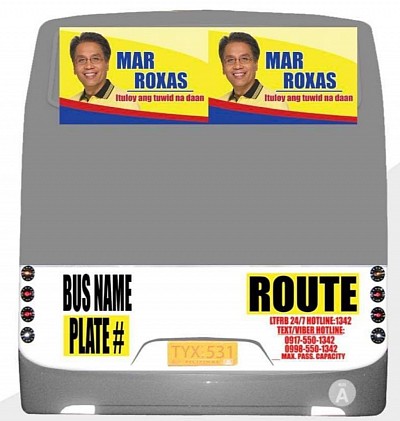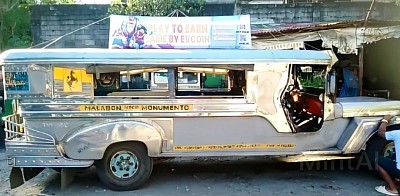KNOWLEDGE AND FEATURE PAGE. Significant Facts About Transit Advertising in the Philippines.
Political or Election Campaign Ads using Transit Advertising.
Election campaign ads are promotional materials created by candidates, parties, or interest groups to campaign for political office during an election cycle.
Characteristics:
-Content Focused: Typically focus on the candidate’s policies, character, qualifications, and vision for the future.
-Targeting: Often aimed at specific voter demographics based on age, socioeconomic status, or political affiliation.
Benefits:
- Directly engages voters and can influence public perception and voter turnout.
- Depends on strategic placements and messaging to resonate with target audiences.
Considerations:
- Subject to strict regulations regarding funding, disclosure, and content (e.g., truth in advertising).
- The effectiveness can be measured through metrics such as increased name recognition or shifts in poll numbers.
- High costs, especially during competitive election cycles, and the necessity for compliance with campaign finance laws.
Intersection of Both
Transit advertising can be a valuable component of election campaigns, especially in major urban centers where public transportation is widely used. Campaigners can use transit spaces to increase visibility and engagement with voters on their daily commutes.
Key Takeaways
-Strategic Use: Candidates may utilize transit advertising to increase their presence in targeted areas, particularly among demographics that heavily use public transportation.
-Regulatory Compliance: Both forms of advertising must adhere to local regulations, with additional scrutiny on election ads regarding their funding and messaging.
-Impact Measurement: The effectiveness of transit advertising in the election context can be gauged through changes in public awareness, voter turnout, and polling data.
This combination of transit advertising and election marketing can enhance a candidate’s reach and make a significant impact on their campaign strategy.
Transit Advertising in the Philippines during Christmas Season.
The Christmas season is a peak time for transit advertising, as many people travel for shopping, holiday festivities, and family gatherings. Here are some key aspects to consider regarding transit advertising during this festive period:
1. High Visibility
- increased Foot Traffic: During the holiday season, public transit stations and vehicles see a surge in passengers, providing advertisers with a broader audience.
2. Creative Campaigns
- Seasonal Themes: Utilizing holiday-themed designs and messaging can enhance engagement. Ads that evoke festive sentiments tend to resonate well with passengers.
3. Emphasizing Localism
- Supporting Local Businesses: Advertisers can promote local events, shopping districts, and services relevant to the community during the holidays.
- Community Engagement: Ads that give back to the community or highlight local charitable initiatives can resonate well and create a positive brand image.
4. Timing and Duration
- Campaign Schedule: Planning campaigns to run from late November through early January can capture the entire holiday shopping season.
- Frequency: Frequent rotation of ads can maintain audience interest throughout the season, introducing new promotions as the holiday approaches.
5. Promotional Offers
- Seasonal Discounts: Highlighting special holiday discounts or promotions can drive immediate action from consumers who are in shopping mode.
- Event Promotions: Advertising local holiday events or festivals can encourage participation and increase brand visibility.
Transit advertising during the Christmas season offers unique opportunities for brands to connect with a wide audience. By leveraging the festive spirit, creative campaigns, and strategic placements, advertisers can effectively reach potential customers and drive engagement during this vibrant time of year.
THE CORE OF JEEPNEY ADVERTISING CAMPAIGN.
The essence of a jeepney advertising campaign is to capture the vibrant and dynamic spirit of Filipino culture, using the iconic jeepney as a symbol of community, connection, and creativity. By incorporating colorful designs, catchy slogans, and engaging visuals, the campaign aims to showcase the unique characteristics of the Philippines and its people, while also promoting a sense of pride and identity among commuters and passersby. Through this campaign, advertisers can effectively reach a wide audience and establish a strong presence in the local market, creating a memorable and impactful brand experience.
READ. https://www.rappler.com/business/video-modern-jeepney-philippines-explainer/
THE BIRTH OF TRANSIT ADVERTISING IN THE PHILIPPINES.
Transit advertising in the Philippines can be traced back to the early 1900s. The first form of transit advertising was through traditional billboards, which were placed along roadsides, highways, and major streets to target pedestrians and motorists. These billboards often showcased products, services, and events.
However, it was not until the 1970s and 1980s that transit advertising began to evolve and expand. This was primarily due to the increasing popularity of buses as a mode of transportation in major cities like Manila. Bus companies started allowing advertisers to display advertisements on the exterior and interior of their buses, opening up a new avenue for brands to reach a wider audience.
The introduction of transit advertising on buses brought about the concept of bus wraps, where the entire exterior of the bus is covered with an advertisement. This proved to be an effective advertising medium as it provided a moving billboard that could capture the attention of pedestrians and motorists alike.
As time went on, different forms of transit advertising emerged. This included the installation of digital screens inside buses, allowing for dynamic and interactive advertisements. Advertisers also started utilizing taxis, jeepneys, trains, and even tricycles for transit advertising.
Today, transit advertising continues to thrive in the Philippines. With the rise of ride-hailing services like Grab and Uber, advertisers now also have the opportunity to target a specific demographic through these platforms. The use of transit advertising has become a popular and effective marketing strategy for brands in the Philippines, allowing them to reach a wide range of consumers while they are on the move.
TRANSIT ADVERTISING PHILIPPINES IN THE NEW ERA.
In 2024, transit advertising in the Philippines is expected to continue to grow in popularity and effectiveness as more brands and businesses recognize the value of reaching a captive audience through buses, taxis, trains, and other forms of public transportation.
With the increasing urbanization and traffic congestion in major cities like Metro Manila, transit advertising offers a unique opportunity to target commuters who spend a significant amount of time traveling each day. This form of advertising allows brands to reach a diverse audience and generate high levels of visibility and brand awareness.
In 2024, we can also expect to see advancements in digital transit advertising, with the introduction of interactive displays, location-based targeting, and real-time tracking of ad performance. This will help advertisers better optimize their campaigns and reach their target audience more effectively.
Overall, transit advertising in the Philippines is set to play a crucial role in the marketing strategies of brands looking to make a lasting impression on consumers in a dynamic and competitive market.
TRANSIT ADVERTISING PHILIPPINES ONLINE AND OFFLINE INTEGRATION.
Transit advertising online and offline integration refers to the practice of combining traditional out-of-home advertising with digital marketing techniques to create a cohesive and integrated advertising campaign.
There are several ways to achieve this integration:
QR Codes and Mobile Apps: Transit advertisements can include QR codes or prompts for users to download a mobile app to engage with the brand online. Users can scan the QR code or download the app to access exclusive content, discounts, or promotions.
Social Media Integration: Transit advertisements can include social media handles or hashtags, encouraging commuters to engage with the brand online. This can include running social media contests or campaigns that drive user-generated content related to the transit ads.
Geotargeting and Retargeting: By utilizing location-based technologies, transit advertisements can target specific audiences in a particular area. Additionally, retargeting techniques can be employed to display online ads to users who have viewed or interacted with the transit ad offline.
Enhanced Tracking and Analytics: Integrating online and offline transit advertising allows for enhanced tracking and analytics. By leveraging digital techniques, advertisers can measure the effectiveness of their campaigns, track reach, engagement, and conversions.
Benefits of integrating online and offline transit advertising include:
Greater Reach and Engagement: By combining online and offline advertising, brands can reach a wider audience and increase brand exposure while also driving engagement and interactions online.
Enhanced Data and Insights: The integration of online and offline advertising allows for better data tracking and insights. Advertisers can measure the success and effectiveness of their campaigns in real-time, enabling data-driven decision-making.
Seamless Customer Journey: Integrating online and offline advertising creates a seamless advertiser journey. Commuters can transition from seeing a transit ad to engaging with the brand online, resulting in a cohesive experience that can increase brand loyalty.
Cost Efficiency: Combining online and offline advertising can be cost-effective as it leverages existing transit advertisements and utilizes digital channels that offer cost-efficient targeting options.
Overall, integrating online and offline transit advertising creates a holistic and effective marketing/advertising campaign that maximizes reach, engagement, and conversion opportunities for brands.




